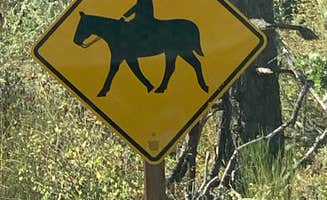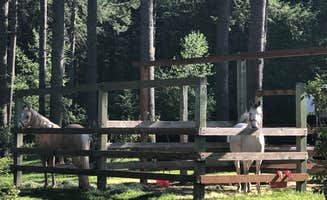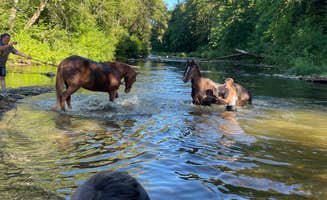Equestrian camping near Oregon City, Oregon offers diverse terrain for trail riders across the Willamette Valley and Mt. Hood National Forest regions. With elevations ranging from 300 to 2,500 feet, riders encounter varied landscapes from riparian zones to conifer forests. Most equestrian campgrounds maintain accessible facilities year-round, though winter trail conditions often include mud and occasional ice.
What to do
Trail riding along river corridors: Access miles of horse-friendly trails at Milo McIver State Park where riders can follow paths to the Clackamas River. "LOTS of nice, wide horse trails for horse riding enthusiasts. We all made s'mores and sang campfire songs together in the evening after our day of hiking to the horse camp and up to the bat haven," notes Melissa L.
Mountain biking alternative: When not riding horses, many campers bring bikes to explore extensive trail networks. At Dairy Creek West — L.L. Stub Stewart Memorial State Park, riders find "access to the Banks-Vernonia State Trail, several disc golf courses, cabins, a horse camp, a day use picnic/event area and a hike-in camp area," according to Shane B.
Fishing access points: Several equestrian campgrounds offer direct fishing access. "Milo McIver State Park also accommodates equestrians with wide horse trails and river access," explains a reviewer. The park provides "salmon fishing within driving distance inside of the park" as noted by Hahns R.
What campers like
Privacy between corrals: Equestrian sites typically offer more separation than standard campsites. At Willamette Mission State Park Horse Camp, "the trails are absolutely gorgeous- it felt like being out in the wild," shares a camper who rated the experience 5 stars.
Year-round accessibility: Many equestrian sites remain open when other campgrounds close. "The park remains open year-round, making it easily accessible from anywhere in northwestern Oregon," notes a camper about Stub Stewart State Park. Another mentions that Battle Ground Lake State Park offers "first come, first serve as well as reservable sites" with good availability in winter.
Multi-use trail connections: Equestrian campers appreciate parks with diverse trail systems. At Beacon Rock State Park, a reviewer mentions "several trails spur off the back side of the camp" with "access to the trail system beyond the Beacon Rock trail." The park offers "lots of trails and paved paths" with "opportunities for fishing also."
What you should know
Facilities vary significantly: While some equestrian campgrounds offer full amenities, others provide only basics. At Oxbow Regional Park, "there are strict no dogs and no alcohol policies (and lots of rules posted everywhere)," notes Stephanie Z., which impacts some campers' experience.
Seasonal crowding impacts: Summer weekends see highest demand for equestrian sites. "It fills up quickly on the weekends, so if you don't have a site reserved I highly recommend getting there early," advises a visitor to Panther Creek Campground. At Silver Falls State Park, sites in summer often require reservations months in advance.
Trail condition reporting: Trails may become impassable after heavy rain. "This park floods every winter. I advise planning your trip for the spring or summer," warns Kelly N. about Willamette Mission State Park. Always check recent trail reports before hauling horses to any destination.
Tips for camping with families
Playground access for non-riders: Many equestrian campgrounds include facilities for children who aren't riding. At Battle Ground Lake State Park, "the kids playground was great for the grandkids," and "large playground but not in the shade," mention different reviewers.
Swimming options nearby: After riding, families appreciate cooling off. Battle Ground Lake features "a cool volcanic lake with a swimming area and great fishing. Its like a mini crater lake," describes Ashley Y. The lake has "a swimming area roped off, and a small sand area for the kids to play."
Educational opportunities: Several equestrian campgrounds incorporate nature education. At Willamette Mission State Park, "a lot of work has been done to keep this site up for public education and trails - we take elementary students to this site every spring to have a field science day," explains Kelly N. The park also features "the largest Black Cottonwood tree" which can become an educational stop.
Tips from RVers
Hookup locations: When parking horse trailers with living quarters, hookup placement matters. At Jantzen Beach RV Park, "water pressure is the lowest we've ever experienced," reports Jennifer H., noting that "all of the folks we've talked to are experiencing the same." This is important for washing down horses and equipment.
Site leveling challenges: Many equestrian camps have uneven parking areas. At Beacon Rock State Park, some sites are "split-level, in that you park up top and walk a few steps down to your camp site," notes Brian C., which can complicate positioning larger horse trailers.
Horse-specific amenities: Look for campgrounds with proper facilities. Silver Falls State Park provides "showers, and nature trails around the campground," while Milo McIver offers "potable water stations and a modern bathhouse with hot showers," essential after a day of riding.




